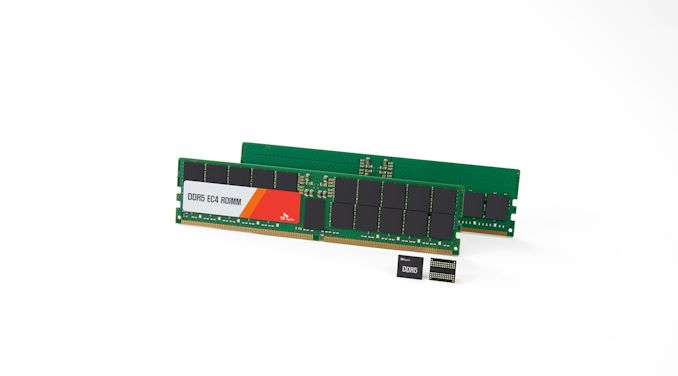SK Hynix to Manufacture 48 GiB and 96 GiB DDR5 Modules
by Dr. Ian Cutress on December 14, 2021 8:37 PM EST
Today SK Hynix is announcing the sampling of its next generation DDR5 memory. The headline is the commercialization of a new 24 gigabit die, offering 50% more capacity than the leading 16 gigabit dies currently used on high-capacity DDR5. Along with reportedly reducing power consumption by 25% by using SK Hynix’s latest 1a nm process node and EUV technology, what fascinates me most is that we’re going to get, for the first time in the PC space (to my knowledge), memory modules that are no longer powers of two.
For PC-based DDR memory, all the way back from DDR1 and prior, memory modules have been configured as a power of two in terms of storage. Whether that’s 16 MiB to 256 MiB to 2 GiB to 32 GiB, I’m fairly certain that all of the memory modules that I’ve ever handled have been powers of two. The new announcement from SK Hynix showcases that the new 24 gigabit dies will allow the company to build DDR5 modules in capacities of 48 GiB and 96 GiB.
To be clear, the DDR5 official specification actually allows for capacities that are not direct powers of two. If we look to other types of memory, powers of two have been thrown out the window for a while, such as in smartphones. However PCs and Servers, as least the traditional ones, have followed the power of two mantra. One of the changes in memory design that is now driving regular modules to non-power of two capacities is that it is getting harder and harder to scale DRAM capacities. The time it takes to figure out the complexity of the technology to get a 2x improvement every time is too long, and memory vendors will start taking those intermediate steps to get product to market.
In traditional fashion though, these chips and modules will be earmarked for server use first, for ECC and RDIMM designs. That’s the market that will absorb the early adopter cost of the hardware, and SK Hynix even says that the modules are expected to power high performance servers, particularly in machine learning as well as other HPC situations. One of the quotes on the SK Hynix press release was from Intel’s Data Center Group, so if there is any synergy related to support and deployment, that’s probably the place to start. A server CPU with 8x 64-bit channels and 2 DIMMs per channel gives 16 modules, and 16 x 48 GiB enables 768 GiB capacity.
As to when this technology will come to the consumer market, we’re going to have to be mindful of cost and assume that these chips will be used on high-cost hardware. So perhaps 48 GiB UDIMMs will be the first to market, although there’s a small possibility 24 GiB UDIMMs might make an appearance. Suddenly that 128 GiB limit on a modern gaming desktop will grow to 192 GiB.
Source: SKHynix Newsroom










22 Comments
View All Comments
Adam7288 - Tuesday, December 14, 2021 - link
They should just call it 10drballsystemlord - Tuesday, December 14, 2021 - link
I want 5!!! (Not a power of two. ;) )StevoLincolnite - Wednesday, December 15, 2021 - link
12GB is still powers of two though. 8 bits in a byte still a power of 2 at the end of the day...Wrs - Wednesday, December 15, 2021 - link
Nah there's a 3 in there that prevents it from being 2^n where n is a whole numbermeacupla - Tuesday, December 14, 2021 - link
huh, interesting.So you're saying we might also get 6GiB and 12GiB modules?
Because 12GiB, and 24GiB configuration on laptops were really annoying, knowing you only had it working in single channel mode.
kobblestown - Wednesday, December 15, 2021 - link
That's not exactly true. With 6GB (4GB + 2GB modules) you have 4 GB (2GB + 2GB) in dual channel and only the rest of the bigger module is in single channel. Actually, a 6GB module will make it possible to have 6GB in single channel mode :)willis936 - Wednesday, December 15, 2021 - link
More modules more money. Laptop vendors are saving money with these setups. Also, asymmetric channel loading has never been in a single supported memory configuration of any motherboard or CPU. It might work, but I'd be shocked if it worked in dual channel mode.Darkknight512 - Tuesday, December 28, 2021 - link
This isn't correct at all, multiple platforms support asymmetric dual channel configs.Alexvrb - Sunday, January 2, 2022 - link
A lot of modern Intel chips support it, mainly mobile chips IIRC. I can't recall seeing support for async dual channel on any AMD chips, which wouldn't really be an issue if laptop manufacturers didn't do weird s*%^ - like solder 4GB on the mainboard and leave a single DIMM slot to handle the other channel. Even if it was properly balanced to start with in a shipping configuration, it makes RAM "upgrades" really awful.Oh that reminds me, I did have a Socket 7 system where you couldn't exceed 64MB of memory or you'd lose cache. Chipset limitation... 430TX or maybe older, can't recall now.
StevoLincolnite - Wednesday, December 15, 2021 - link
Having 6Gb of Ram doesn't mean it is running in single channel.It means it runs in Asynchronous dual channel mode where the first 4GB is interleaved, but the last 2GB is not.